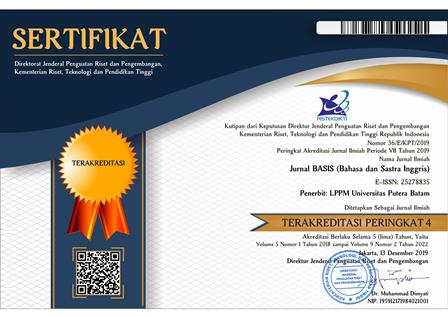COMPONENTS OF LOVE IN ASMA NADIA’S NOVEL ASSALAMUALAIKUM BEIJING
DOI:
https://doi.org/10.33884/basisupb.v7i2.2483Keywords:
Peer Assisted Learning, Listening Comprehension, MotivationAbstract
This study was aimed at investigating the effects of Podcast with Peer Assisted Learning in the EFL listening classroom. In conducting this research, pre-experimental design was used. The sample of this study was selected by using simple random sampling involving 27 students as the sample. The data collected were analyzed by using t-test (paired sample t-test) and percentage for two questionnaires, students’ motivation and perception. The result showed that (a) there was a significant difference in listening comprehension achievement before and after being taught by using Podcast with Peer Assisted Learning where t-obtained was 8.921 and the significance value was 0.000 which less than 0.05. On the basis of this result, it can be inferred that listening comprehension achievement of students before and after teaching by using podcast with peer-assisted learning was substantially improved. (b) The percentage score for learning motivation from the students was (55.6%) in high level, moderate 29.6% and low level was (5%). This score was considered students have high level of learning motivation. (c) most of the students gave positive perceptions on the use podcast with peer assisted learning in listening classroom. It can be concluded that teaching using podcast with peer assisted learning can develop the students listening comprehension achievement.
References
Buck, G. (2001). Assessing Listening. Cambridge: Cambridge University Press.
Brown,H.D.(2011). Language assessment:Principles and classroom practice. New York : Pearson Education, Inc.
Brown, H.D. (2002). Strategies for success. New York : Longman.
Cresswell, J.W. (2012). Educational research; planning, conducting, and evaluating quantitative and qualitative research (4th edition). New York: Pearson.
Dornyei, Z. (2001). Teaching and researching motivation. England: Pearson Education.
Fraenkel,J.R & Wallen, N.E (2009). How to Design and Evaluate Research in Education (7th ed). New York. McGraw-hill
Goh, C.C.M. (2000). A cognitive perspective on language learners’ listening comprehension problems. System, 28:55-75
Johan, et.al (2015). Gangguann reseptif mahasiswa dalam menjawab soal-soal listening: Suatu kajian neuropragmatik. Basis Journal. 1 (2), (33-39) at <http://ejournal.upbatam.ac.id/index.php/basis/article/view/550>. Date accessed: 27 sep. 2020.
Kawas, S.A. (2017). Peer-assisted learning associated with team-based learning in dental education. Health Professions education, 3, 38-43.
Kubanyiova, M. (2006). Developing a motivational teaching practice EFL teachers in Slovakia: Challenges of promoting teacher change in EFL context. TESL-EJ, 10(5), 1-17.
McMaster, K. (2008). Implementing evidence based practices with at-risk readers: Effects of PALS for kindergarten English learners. Asheville : NC.
Mendleshohn, D.J. & Rubin, J. (1995). A guide for the teaching of second language listening. San Diego, CA : Dominie Press.
Nelson, P.E. & Pearson J.C. (1994). Understanding and sharing: An introduction to speech communication. New York : WCB Brown& Benchmark Publishsers.
O’Bryan, A., & Hegelheimer, V. (2007). Integrating CALL into the classroom: The role of podcasting in an ESL listening strategies course. ReCALL, 19(2), 162-180. http://dx.doi.org/10.1017/S0958344007000523
Richards, J. C. (2008). Teaching listening and speaking from Theory to practice. New York: Cambridge University Press. Retrieved from http://www.cambridge.org/elt/teacher-supprt/pdf/Richards- Teaching Listening- Speaking.pdf.
Rosell-Aguilar, F. (2009). Podcasting for language learning: Re-examining thepotential. In the next generation: social networking and online collaboration in foreign language learning, 13-34. Ed. by L. Lomicka & G. Lord. Callico, Texas: San Marco.
Saricoban, Arif. (1995). The teaching of listening. The Internet TESL Journal. 5.(12): 1. Retrieved from http://iteslj.org/articles/Saricoban_listening.html
Rosell, Aguilar, F. (2007). Top of the pods—in search of a podcasting “podagogy” for language learning. Computer Assisted Language Learning, 20(5), 471-492. http://dx.doi.org/10.1080/09588220701746047
Rost, M. (1991). Listening in action: Activities for developing listening in language teaching. Englewood Cliffs, NJ: Prentice Hall.
Stanley, G. (2006). Podcasting: Audio on the internet comes of age. TESL-EJ, 9(4), 1-7.
Tariq, V.N. (2005). Introduction and evaluation of peer-assisted learning in first year undergraduate bioscience. BEE-J, 6(8), 21-39.
Tompkins, G. E. & Hoskisson, K. 1995. Language Arts: Contents and Teaching Strategies (3rd ed.). New Jersey: Prentice Hall.
Tomlinson, B. (1998). Materials development in languagee teaching. Cambridge: Cambridge University Press.
Toping, K & Ehly, S. (2009). Peer Assisted Learning. Routledge, New York:USA.
Downloads
Published
Issue
Section
License

















